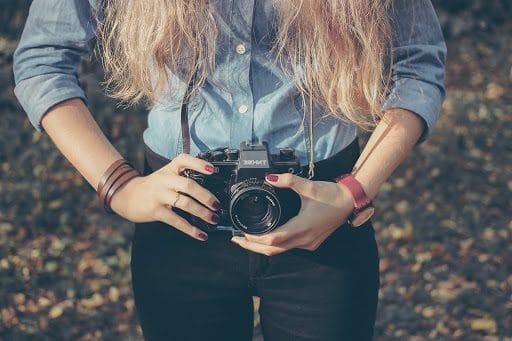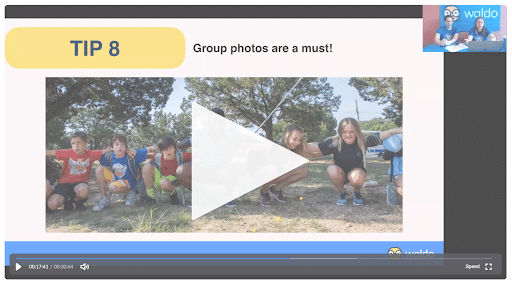
We’ve created a free webinar presentation to accompany this post — watch it here.
*Snap snap snap!*
As your camera flashes away with dozens of camper photos, you can’t help but wonder: Are these photos good enough for the camp AND will the campers and their families love them? Do I have enough energy to last the day? Am I capturing most of the campers?
Being a camp photographer is a tough job — the days are long, you’re constantly on your feet, you cover lots of ground and you have to keep your energy up. It’s a big responsibility. Your photos form the face of the camp on social media, and you are in many ways the window into the camper’s experience for parents. They look to you to capture their camper and provide them the glimpse they are looking for into their camper’s experience. On top of that, your photos also form the memorabilia campers will cherish for the years to come.
Nailing your camp photography methods down early will improve the quality of the photos you capture. You want campers to see you as a “counselor with a camera.” Building trust with the campers is going to make for better photos.
Producing high-quality photos ensures you build a great portfolio for yourself, but more importantly, you help contribute to the camp’s brand image online too. This, in turn, generates marketing value for your camp — higher quality photos means a higher likelihood to be shared by campers and parents online. However, it’ll be challenging to keep up your quality and still capture the number of photos needed per day in order to cover most of the campers.
That said, here are 10 tips all camp photographers should take note of to improve their photography work at summer camps.
If you are looking to hire a photographer for your camp, check out our Camp Photographer Recruitment Guide.
10 Tips Camp Photographers Need to Know to Deliver Effective Photography
1. Have a Plan
Perhaps the biggest challenge to camp photography is making sure you’ve captured photos of each individual camper. Since early photos can be some of the most important photos for settling the nerves of first-time parents, one way to address this is to implement an Opening Day photo-op for campers. Something such as snapping a photo of each camper with the camp director will help you get a photo of each individual camper within a 3-4 hour timespan. As an added bonus, you captured all those photos without having to run around camp all day.
Another way to plan ahead is to pinpoint the activities that would have the most campers in attendance and snap photos there. This will increase your odds of snapping photos of most of the campers. During rest hours, you can check which categories of campers you’ve captured well and where you may have gaps. It’s impossible to know if you’ve got every camper, but having categories will help get you closer to that goal. Use cabin sheets to cross off names and see who you missed.
2. Don’t be afraid to supplement with phones
We get it, you’re cringing right now at the thought of photos taken via a smartphone. While perfectly edited professional photos are great, the reality is that parents would rather see imperfect photos of their kids than get no photos at all.
Recruit the help of directors and counselors to snap photos of the campers throughout the day, and compile it into a shared gallery at the end of the day. This is yet another way to ensure you’re getting photos of each camper, which, once again, leads to happy parents. You can cull the blinks and blurries but you’ll still end up with some extra shots which are valuable.
With Waldo’s shared galleries, it is easy to get everyone contributing to the same gallery or album. Within a few clicks, invites can be sent to every counselor to contribute their photos. These photos can go into “require review” where you can curate those you feel are good for publishing.
3. Have a plan for your day off
While it may be tempting to be the “super-photog” and take photos all day, every day, the truth is that you’re going to need a break. Running around taking photos all day is hard work, and you need rest in order to revitalize and get back to snapping all those awesome shots.
Communication is your best friend when it comes to your days off. If they are planned ahead of time, you can let parents know which specific days of camp they can expect that there will not be as many photos coming. This way, parents already know what to expect and will not worry or wonder when they aren’t receiving as many photos that day.
You can also recruit other camp staff who are interested in photography to either snap extra photos on their phones that day or even use your camera if they’re savvy enough to.
4. Dealing with night events
Some of the most cherished photos come from dances and other nighttime events at camp. Nothing melts a momma’s heart like their kid’s 1st dance.
Of course, those low lighting conditions mean it’s harder to capture photos that look good. This is where a nice external flash is going to come in handy. You can find them for $100-150, and they are well worth the investment. In addition, having an 18-200mm lens will help ensure that you get good quality photos in whatever environment you’re in.
Hint: It’s ok to buy used when it comes to photography equipment; in fact, it’s actually smart to do so because of the depreciation!
5. Watch for “camper signals”

You may not realize this, but campers are communicating with their parents in every photo you take of them. For example, a thumbs-up is a pretty common way to tell Mom and Dad “I feel safe and I’m having a good time!” However, what if you noticed one smiling camper was consistently using a different hand signal (holding a certain number of fingers up, for instance)? This can be a way for them to communicate distress to their parents.
While you may not get a parent phone call based on that photo, not noticing and addressing the potential distress diligently may mean not seeing that camper returning next summer. By noticing camper signals, you can be proactive in talking to the camper or parents about potential issues.
6. Always capture smiles… even in the background.

Sure, it’s pretty obvious that the campers in the foreground of your photo should be smiling, but be sure to check that the background campers are having a good time as well. If smiling is an issue for your campers, come up with incentives for them to smile. Competitions and prizes that encourage and reward their enthusiasm will help you get those pearly whites on camera.
Best case scenario: Waldo’s facial recognition picks up a camper’s smiling face in the background and delivers it through mobile instantly to their parent, and bam — you have another delighted parent!
7. Don’t keep every photo you take
This might sound pretty obvious, but you’re going to have a ton of photos by the end of each day — not every photo is going to be worthy of publishing. If you like to run your photos through a program like Lightroom for post-processing, you can rate them there and cull out the weakest ones.
Another excellent alternative: you can send them to Require Review on Waldo, curate them there before publishing, and mark the best ones as Highlights. These will show up in a highlight reel in the app, giving parents a condensed view of the day via the 20 – 30 best photos. They’ll love you for it and it makes the camp look great. These highlights are also marketing gold once the season is over.
8. Group photos are a must
We don’t recommend setting yourself up for failure with the unreasonable task of getting individual photos of each camper every day. Socializing at camp is a key part of a camper’s experience so you should capture it. One easy method to help you get photos of all campers is to use lunch breaks to snap photos of each cabin enjoying their meal together.
9. Reassure parents with photos
Parents want to know that they’re leaving their kids in the care of safe, friendly counselors. When you capture photos of campers smiling with their counselors, this helps send that message to parents.
Don’t fall into the trap of thinking that you only do this for younger or newer campers; it’s equally important for the return campers and teenagers as well. Parents always want to know that their kids are in good hands, no matter the age of the camper.
These endearing moments when their child is being loved and cared for by a counselor are priceless moments.
10. Upload daily & track your coverage (+ storage tips!)
To maximize the value of your photography online, you should upload your photos daily as parents will post them more frequently. These posts provide significant marketing value for your camp, as like-minded families are connected to your current families online.
Many camps begrudge the pressure of taking lots of photos and posting them every day. However, we encourage you to embrace this as your #1 marketing method. It may feel like your parents have unreasonable expectations, but give them what they crave — and they will become an unpaid social marketing army for you.
Services like Waldo will add your brand filter to every photo and auto-hash your parent’s Facebook post with your camp’s hashtag. You can also use services like Waldo to track the number of photos taken of each camper. This allows you to smooth out the coverage across your campers and ensure your families have plenty of photos to post!
When it comes to storage, do not rely on your computer’s hard drive to do all that heavy lifting. We recommend you use external hard drives to store your photos; a 1 TB hard drive will last for 2-3 years worth of camps. Using external hard drives will also keep you from running into storage issues that affect your computer’s software.
On top of that, getting your photos saved in cloud storages adds another safety net to your photography collection. Some services like Waldo will store multiple years worth of photos for free. Make sure you use high-quality cloud photo storage solutions like Waldo so that your photos are stored redundantly and safely, without incurring additional storage costs.
With both ways, you have an additional archive in case your computer’s hard drive were to crash. Photos are so valuable to both your families and camp marketing, so you’d definitely want to protect all your hard work.
Watch the Free Webinar Presentation
To get the full picture of the tips in this post as well as understand how Waldo could play a part in improving your summer camp photography, make sure you tune in to our free webinar presentation. For any further questions, feel free to get in touch with our team — we’ll be glad to help you!








